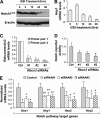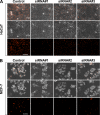Rabconnectin-3 is a functional regulator of mammalian Notch signaling
- PMID: 20810660
- PMCID: PMC2966091
- DOI: 10.1074/jbc.M110.158634
Rabconnectin-3 is a functional regulator of mammalian Notch signaling
Abstract
The Notch signaling pathway is important for cell fate decisions in embryonic development and adult life. Defining the functional importance of the Notch pathway in these contexts requires the elucidation of essential signal transduction components that have not been fully characterized. Here, we show that Rabconnectin-3B is required for the Notch pathway in mammalian cells. siRNA-mediated silencing of Rabconnectin-3B in mammalian cells attenuated Notch signaling and disrupted the activation and nuclear accumulation of the Notch target Hes1. Rabconnectin-3B knockdown also disrupted V-ATPase activity in mammalian cells, consistent with previous observations in Drosophila. Pharmacological inhibition of the V-ATPase complex significantly reduced Notch signaling in mammalian cells. Finally, Rabconnectin-3B knockdown phenocopied functional disruption of Notch signaling during osteoclast differentiation. Collectively, these findings define an important role for Rabconnectin-3 and V-ATPase activity in the Notch signaling pathway in mammalian cells.
Figures





Similar articles
-
The vacuolar proton pump, V-ATPase, is required for notch signaling and endosomal trafficking in Drosophila.Dev Cell. 2009 Sep;17(3):387-402. doi: 10.1016/j.devcel.2009.07.001. Dev Cell. 2009. PMID: 19758563 Free PMC article.
-
Multiple roles of Notch signaling in the regulation of epidermal development.Dev Cell. 2008 Apr;14(4):594-604. doi: 10.1016/j.devcel.2008.01.017. Dev Cell. 2008. PMID: 18410734
-
Nemo-like kinase suppresses Notch signalling by interfering with formation of the Notch active transcriptional complex.Nat Cell Biol. 2010 Mar;12(3):278-85. doi: 10.1038/ncb2028. Epub 2010 Jan 31. Nat Cell Biol. 2010. PMID: 20118921
-
From fly wings to targeted cancer therapies: a centennial for notch signaling.Cancer Cell. 2014 Mar 17;25(3):318-34. doi: 10.1016/j.ccr.2014.02.018. Cancer Cell. 2014. PMID: 24651013 Free PMC article. Review.
-
Genetic visualization of notch signaling in mammalian neurogenesis.Cell Mol Life Sci. 2013 Jun;70(12):2045-57. doi: 10.1007/s00018-012-1151-x. Epub 2012 Sep 13. Cell Mol Life Sci. 2013. PMID: 22971775 Free PMC article. Review.
Cited by
-
The RAVE complex is an isoform-specific V-ATPase assembly factor in yeast.Mol Biol Cell. 2014 Feb;25(3):356-67. doi: 10.1091/mbc.E13-05-0231. Epub 2013 Dec 4. Mol Biol Cell. 2014. PMID: 24307682 Free PMC article.
-
WDR72 models of structure and function: a stage-specific regulator of enamel mineralization.Matrix Biol. 2014 Sep;38:48-58. doi: 10.1016/j.matbio.2014.06.005. Epub 2014 Jul 4. Matrix Biol. 2014. PMID: 25008349 Free PMC article.
-
Lysosome as a Central Hub for Rewiring PH Homeostasis in Tumors.Cancers (Basel). 2020 Aug 27;12(9):2437. doi: 10.3390/cancers12092437. Cancers (Basel). 2020. PMID: 32867178 Free PMC article.
-
Role of Notch signaling during lipopolysaccharide-induced preterm labor.J Leukoc Biol. 2016 Aug;100(2):261-74. doi: 10.1189/jlb.3HI0515-200RR. Epub 2015 Sep 15. J Leukoc Biol. 2016. PMID: 26373439 Free PMC article.
-
BLOS2 negatively regulates Notch signaling during neural and hematopoietic stem and progenitor cell development.Elife. 2016 Oct 10;5:e18108. doi: 10.7554/eLife.18108. Elife. 2016. PMID: 27719760 Free PMC article.
References
Publication types
MeSH terms
Substances
Grants and funding
LinkOut - more resources
Full Text Sources
Molecular Biology Databases

